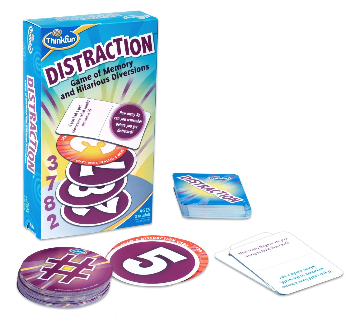In the box: 54 round number cards, 50 rectangle distraction (question) cards - 100 questions total
A short-term memory game that will require you to remember a string of non-sequential numbers, sometimes while being distracted by irrelevant questions and answers.
Distraction consists of two decks of cards. A rectangle deck with questions, and a circular deck with numbers, some of which also say "Draw a distraction card".
Object:
The winner will be the first player to run out of cards.
Set up:
Deal the 54 circular number cards face-down and evenly between all players. Each player will play the game with this stack of face-down cards in front of him. Shuffle the rectangle distraction (question) cards, face-down, and place the stack off to the side.
Play:
Players take turns flipping their top number card and placing it in a central face-up stack in the middle of the players. As each player places their new number card on the top of the stack, they must recite, in order, all numbers before them and end with their number. For instance the first player lays a 4 and says "four". The second player covers the four with a 9 and says "four nine". The third player places a three on the stack and says "four nine three". This goes on until someone turns over and plays a number card that also reads "Draw a distraction card" or until they make a mistake in their number sequence recitation and have to take the whole pile of number cards and put it under their number pile.
 |
| Left - Regular number card. Right - Draw a Distraction number card. |
When you draw a distraction card, you must read the question and answer it before you recite the numbers, in order. The distraction of reading and answering a question will make it harder to remember the string of numbers. The box promised hilarious diversions, so I figured the questions would lend themselves to funny answers. Maybe it was just us, but I didn't feel that the majority of the questions did. Here is a sampling of the questions, you judge for yourself:
- Who is sitting across from you right now?
- If you had to eat a vegetable with vanilla ice cream, what would it be?
- Would you rather have curly hair or straight hair?
- Would you rather be a dancer or a singer?
- Would you rather be stuck outside on a really hot day or a really cold day?
Players figured out right away that if you have a long string of numbers to recite, once you read the question don't sit and ponder an answer, just say the first answer that pops into your head. Reading the question was more distracting than coming up with a answer. If you think that someone made a mistake as they recited the string of numbers, you can challenge them. However, chances are neither you nor anyone else will remember what they said as you go to check the cards on the stack. We did this a few times and since no one could remember we had to let it go. Perhaps one player should sit out and just be a recorder of the numbers and could listen for mistakes. Anyway, the game fell flat for me and was more for fun than training someone to develop a better memory.



No comments:
Post a Comment
Thank you for taking the time to comment.